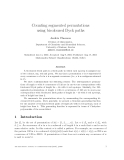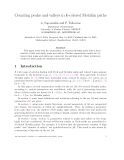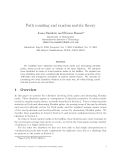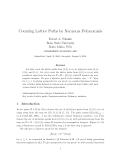
Path counting
-
Tuyển tập các báo cáo nghiên cứu khoa học về toán học trên tạp chí toán học quốc tế đề tài: Counting segmented permutations using bicoloured Dyck paths...
 18p
18p  thulanh5
thulanh5
 14-09-2011
14-09-2011
 37
37
 3
3
 Download
Download
-
Tuyển tập các báo cáo nghiên cứu khoa học trên tạp chí toán học quốc tế đề tài: Counting peaks and valleys in k-colored Motzkin paths...
 20p
20p  thulanh5
thulanh5
 13-09-2011
13-09-2011
 54
54
 3
3
 Download
Download
-
We establish three identities involving Dyck paths and alternating Motzkin paths, whose proofs are based on variants of the same bijection. We interpret these identities in terms of closed random walks on the halfline. We explain how these identities arise from combinatorial interpretations of certain properties of the -Hermite and -Laguerre ensembles of random matrix theory. We conclude by presenting two other identities obtained in the same way, for which finding combinatorial proofs is an open problem....
 16p
16p  thulanh5
thulanh5
 12-09-2011
12-09-2011
 71
71
 4
4
 Download
Download
-
Tuyển tập các báo cáo nghiên cứu khoa học trên tạp chí toán học quốc tế đề tài: Counting Lattice Paths by...
 9p
9p  thulanh4
thulanh4
 10-09-2011
10-09-2011
 45
45
 3
3
 Download
Download
-
Which two statements are true of EIGRP topology depth? (Choose two.) Topology depth should be limited to 15 routers. Redundant links and alternative paths can be used to reduce topology depth. Topology depth is the maximum hop count between any two EIGRP routers in the topology. Route summarization can reduce the convergence time in networks with large depth. Topology depth is the number of router hops necessary for traffic to reach from access layer to core layer. Topology depth refers to the total number of hops that information must travel to reach all EIGRP routers in the network....
 8p
8p  danhson1409
danhson1409
 26-12-2010
26-12-2010
 133
133
 14
14
 Download
Download
-
A routing algorithm constructs routing tables to forward communication packets based on network status information. Rapid inflation of the Internet increases demand for scalable and adaptive network routing algorithms. Conventional protocols such as the Routing Information Protocol (RIP) (Hedrick, 1988) and the Open Shortest-Path First protocol (OSPF) (Comer, 1995) are not adaptive algorithms; they because they only rely on hop count metrics to calculate shortest paths. In large networks, it is difficult to realize an adaptive algorithm based on conventional approaches. ...
 16p
16p  tienvovan
tienvovan
 11-09-2010
11-09-2010
 80
80
 7
7
 Download
Download
CHỦ ĐỀ BẠN MUỐN TÌM



















